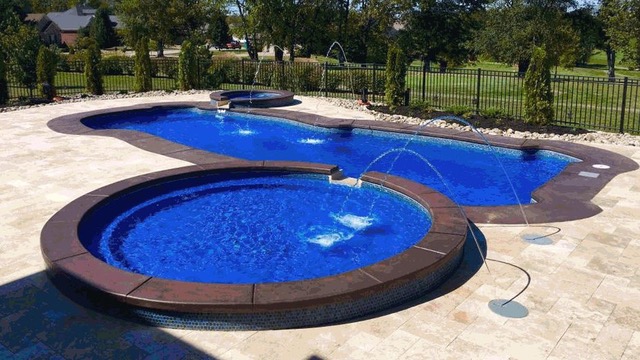Dreaming of a backyard oasis in Virginia but feeling overwhelmed by the permit process? That shiny new fiberglass pool requires proper paperwork before the first shovel hits the ground.
Virginia pool permits might seem like a bureaucratic maze, but they’re actually your best protection against costly mistakes and safety hazards. Understanding the requirements upfront will save you time, money, and stress as you transform your backyard into the perfect summer retreat.
Contents
Who Needs a Pool Permit in Virginia
In Virginia, you need a building permit for any swimming pool larger than 150 square feet or deeper than 24 inches. This requirement applies to both in-ground fiberglass pools and above-ground options under the Virginia Uniform Statewide Building Code. Even smaller pools may require permits in certain counties, so always check with your local building department first.
Many Virginia counties have specific webpages dedicated to pool permits with downloadable applications and checklists. Temporary pools that are dismantled seasonally might have different requirements, but permanent structures almost always need proper documentation.

5 Steps to Get a Pool Permit in Virginia
1. Local Zoning Approval
Start by contacting your local zoning office to verify setback requirements for your property. Most Virginia counties require pools to be at least 10 feet from property lines, though this varies by locality.
We’ve compiled a list of Virginia county pool permit regulations, requirements, and applications for easy access – but make sure to call your local authority to confirm all of the steps you’ll need to take for your specific area.
-
- Chesterfield County, Virginia – Requirements for Outdoor Residential Swimming Pools Guide
- Roanoke County, Virginia – Swimming Pool and Hot Tub Permit Information
- Goochland County, Virginia – Swimming Pool and Spa Codes and Permits
- Charles City, Virginia – Swimming Pool Permit Application Information
- Shenandoah County, Virginia – Residential Pool Application (PDF)
- Isle of Wight, Virginia – Building Code Guidelines for Swimming Pools (PDF)
- New Kent County, Virginia – Pool Permits and Applications, Related Documents, and Inspection Information
- Prince George County, Virginia – Code Compliance Guidelines for Pools, Hot Tubs, and Spas
- Powhatan County, Virginia – Swimming Pools, Hot Tubs, and Spas Residential Construction Permit Application
- York County, Virgnia – Building Code Guidelines For Home Pools (PDF)
- Frederick County, Virginia – Residential Pool Building Permit and Information
- Arlington County, Virginia – Residential Pool Permitting Information
- Gloucester County, Virginia – Swimming Pools and Spas Documents and Details
- Fauquier County, Virginia – Residential Pools, Spas, and Hot Tubs Step by Step Guide
- James City County, Virginia – Guidelines and Safety Regulations for Residential Pools (PDF)
- Matthews County, Virginia – Pool, Spa, and Hot Tub Documents
- Clarke County, Virginia – Residential Swimming Pool Permit Packet
- Amherst County, Virginia – Swimming Pool Building Tip Sheet (PDF)
- Henrico County, Virginia – Swimming Pool, Spa, and Hot Tub Requirements (PDF)
- Amelia County, Virginia – Residential Swimming Pool Requirements and Application
- Cumberland County, Virginia – Pool Building Permit Application (PDF)
- Alleghany County, Virginia – Accessory Structure Permit Information for Residential Pools
- Fluvanna County, Virginia – Pool and Spa Information Documents
- Loudon County, Virginia – Pool Permit Application Information
- Augusta County, Virginia – Residential Swimming Pool Permit Application Process
- Campbell County, Virginia – Pool Permit Application Process
- Fairfax County, Virginia – Miscellaneous Residential Pool Building Permit Information
- King County, Virginia – Swimming Pool and Spa Requirements Document (PDF)
- Greensville County, Virginia – Pool Building Permits and Inspection Information
- Boutetort County, Virginia – Residential Pool Building Details
- Mecklenburg County, Virginia – Pool Building Permits and Related Documents
- Ablemarle County (Charlottesville), Virginia – Residential Pool and Spa Checklist (PDF)
- Spotsylvania County, Virginia – Requirements for Outdoor Residential Swimming Pools, Guide to Permit and Inspections
- Wise County, Virginia – Pool Permits and Fees Information
- Montgomery County, Virginia – Pool/Spa Permit Application (PDF)
- Buckingham County, Virginia – Pool Building Permit Application (PDF)
- Louisa County, Virginia – Pool/Hot Tub Residential Guide, Permit, and Supporting Documents
- Rappahannock County, Virginia – Application for Pool Permit (PDF)
- Stafford County, Virginia – Pools, Spas, and Hot Tubs Permit and Plan Requirements
- Appomattox County, Virginia – Application for Pool Permit (PDF)
- Rockingham County, Virginia – Pool Permit Application Online Portal
If you live in an HOA community, you’ll need their approval before applying for county permits. HOAs often have additional restrictions on pool placement, style, and fencing.
2. Documentation and Plans
Prepare a detailed site plan showing your property boundaries, existing structures, and the proposed pool location with measurements. You’ll need to include pool specifications including dimensions, depth, and construction materials.
Most Virginia counties also require a completed Pool Barrier Responsibility Form that confirms your commitment to installing proper safety barriers.
- Required documents: Site plan, pool specifications, barrier responsibility form, and property survey
- Optional documents: HOA approval letter, manufacturer specifications for fiberglass pools
3. Permit Application Submission
Submit your completed application package either online through your county’s permit portal or in person at the building department. Permit fees vary depending on your locality and pool size.
Processing times vary by county and season, with many jurisdictions experiencing a longer wait during busy summer months. For that reason, we highly suggest Virginia pool permits are generally valid for six months to a year, depending on your locality.
4. Inspection Scheduling
Be prepared for multiple inspections throughout your pool installation process. Most counties require a pre-construction inspection to verify setbacks, a bonding inspection before the pool shell is installed, and a final inspection of completed barriers and safety features. Projects may also include electrical, gas rough-in and final, and a final building or barrier inspection. Your county will confirm the exact sequence when your permit is issued.
Schedule these inspections at least 24-48 hours in advance through your county’s online portal or inspection hotline. Having your permit number and property information ready will speed up this process.
5. Final Approval
After passing your final inspection, you’ll receive official approval documentation. Keep these records with your home improvement files for future reference.
Some counties issue a Certificate of Completion specifically for the pool, while others simply update your property records to reflect the addition.
Safety, Barrier, and Electrical Requirements
Virginia follows the International Swimming Pool and Spa Code for safety requirements. Pools must be surrounded by a barrier at least 48 inches high with self-closing, self-latching gates that open outward. Maximum openings cannot allow a 4-inch sphere to pass, and the gap at the bottom of the barrier should be no more than about 2 inches. If horizontal members are less than 45 inches apart they must face the pool side and vertical members are typically limited to about 1.75 inches of spacing to reduce climbability.
All pool electrical systems must be properly bonded and grounded according to the National Electrical Code. This includes underwater lights, pumps, heaters, and any metal components within 5 feet of the water. Given the risk with water and electricity, hire a licensed electrical contractor for wiring, bonding, and equipment connections.
- Barrier requirements: 48-inch minimum height, no gaps larger than 4 inches, self-closing gates
- Electrical safety: GFCI protection for outlets, proper bonding of all metal components, safe distance from power lines – consult a licensed professional for installation and inspection readiness

Best Practices for Fiberglass Pools
Fiberglass pools offer several advantages when navigating the permit process in Virginia. Their factory-engineered design means exact specifications are available upfront, making permit documentation more straightforward.
In-ground fiberglass pools generally have a shorter installation time than concrete, meaning less time dealing with open permits and multiple inspections. When submitting your fiberglass pool permit application, include the manufacturer’s specifications and installation guidelines.
Virginia building officials appreciate seeing these standardized documents as they help verify code compliance. Always check that your chosen fiberglass pool model meets Virginia’s specific requirements for depth markers, suction outlets, and barrier provisions.
Common Roadblocks to Watch For
1. Incomplete Paperwork
The most common reason for permit delays is missing or incorrect documentation. Double-check all measurements on your site plan and verify that pool specifications match exactly what you’re installing.
Many Virginia counties now require digital submissions with specific file formats, so follow their guidelines precisely to avoid rejection. Having your virginia pool permits rejected can add weeks to your timeline.
2. HOA Restrictions
Homeowners Associations can create significant hurdles in the pool permit process. Some Virginia HOAs prohibit certain pool types, limit sizes, or restrict visible equipment.
Review your HOA covenants thoroughly before applying for county permits, and get written approval from your association board to include with your permit application. This extra step can save you from costly changes later.
Pool Brokers USA: Making the Process Easier
At Pool Brokers USA, we understand that navigating permits can be one of the most stressful parts of installing a fiberglass pool. Our team provides detailed specifications and documentation for all our pool models, making the permit application process smoother.

We offer guidance on local requirements and can help you understand which forms you’ll need for your specific Virginia county. Unlike traditional pool companies that handle everything at premium prices, our approach empowers you to manage the permit process yourself with our support.
Our team has helped many families in Virginia install new in-ground pools and would be happy to assist you in making your backyard dream a reality. Learn more about our pool installation business in Virginia.
Final Thoughts and Next Steps
Securing the proper Virginia pool permits for your in-ground swimming pool project is essential for both legal compliance and safety. While the process may seem daunting, breaking it down into manageable steps makes it achievable for any homeowner.
Remember that requirements can change, so always verify current regulations with your local building department. Your beautiful backyard oasis is worth the effort of proper permitting.
With your permits in hand, you’ll be ready to transform your property with a stunning fiberglass pool that meets all safety standards. Ready to start planning your pool project? Request a quote today and take the first step toward your backyard transformation.
